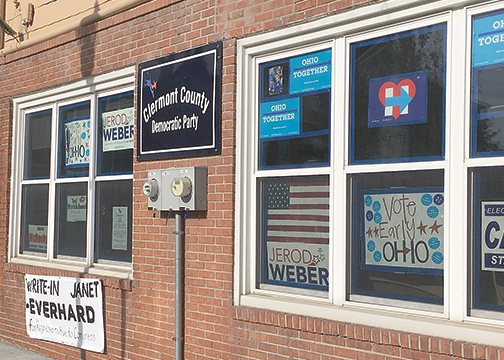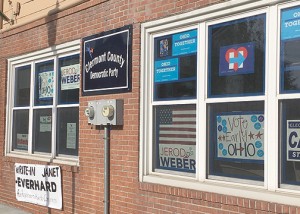

Sun staff
This year, Democratic presidential nominee Hillary Clinton leads the party’s ticket in her race for the White House against Republican presidential nominee Donald Trump, but in Clermont County, no Democrats are running for any of the county’s partisan seats.
The Democratic Party did not put forth a candidate in the races for Judge for the Court of Common Pleas, Commissioner, Prosecutor, Clerk of Courts, Sheriff, Recorder, Treasurer, Engineer or Coroner.
“This is, I’m pretty confident, a function of the fact that we haven’t had a Democrat win an election in the county in multiple decades,” Raymond Lembke, Clermont County Democratic Party Executive Committee chair, said.
A Democrat has not held a countywide partisan seat since 1984.
“What happens, unfortunately, is with the lack of electoral success, is a real deterrent to people,” Lembke said. “Quite frankly, why do you want to run if you don’t really think you have a reasonable shot at winning? So, it deters, particularly, people that would be more attractive candidates.”
Of the county’s 136,477 registered voters, 75,348 are not affiliated with a party, 48,749 are Republicans, 12,312 are Democrats, 44 are Libertarians and 24 are Greens, according to this year’s count.
“I think the conventional wisdom, pretty much across the board, is it is extremely unlikely right now that a Democrat would win an election in Clermont County,” Lembke said, going on to explain that the lack of historical wins also makes it harder for Democrats who are running to fundraise.
“So, if I’m a donor, and I’m given the choice of contributing to a presidential candidate or a senate candidate…where I think there’s a chance that the candidate I support might actually win, or am I going to contribute to somebody running for commissioner or auditor in what has now become a historically Republican county, I’m probably not; I mean, what’s the return on my investment from that,” he said, adding, “And, that’s something, frankly, we have to turn around.”
The Democratic Party has considered two approaches when it comes to putting forth candidates for countywide partisan seats.
“Theory number one is you run people for everything, for the reason, in part, just for the appearance – remind everybody that we’re here – recognizing that they’re not in a position to make a real serious effort,” Lembke said.
“Of course, that takes a potential candidate going along with that.”
However, that tactic raises questions about whether or not the party is “defusing its efforts.”
“Maybe if you just pick one or two candidates that you think might have a real shot, and put all your resources behind them, they might actually win,” Lembke said. “You can go either way on it.”
He added, “The reality of the situation is a lot of people don’t want to be just kind of a placeholder candidate.”
Despite this year’s nonexistent slate of Democratic candidates for countywide partisan seats, Lembke is confident things will change in the future.
“We are getting some younger, energetic people that are starting to get involved; that’s essential because a lot of us are getting older and we’re not going to be here forever,” he said. “And, I think as you get those younger people, and as we see the population of the county changing, I think we’re going to get more people going to run; I think we’re going to get more people willing to look at our candidates.”
He added, “I keep reading that younger voters are nowhere near as big on party identification and party loyalty as older people are.”
